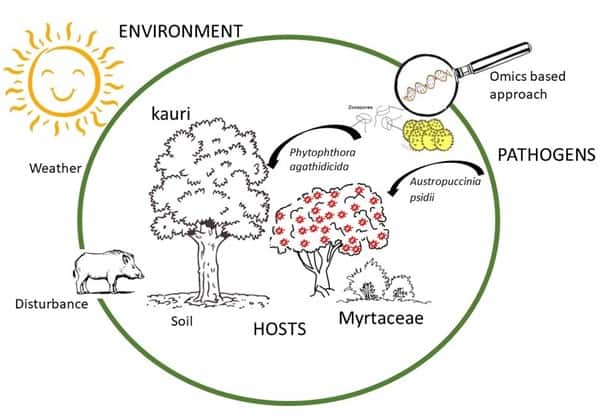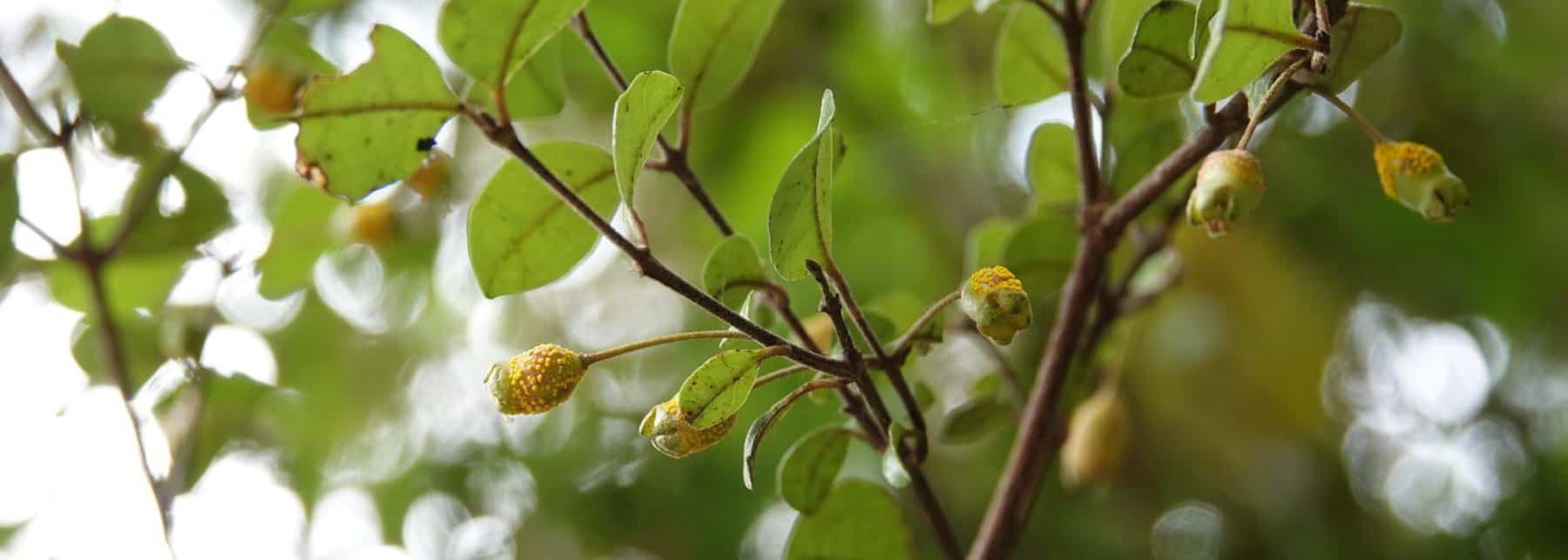Juliane Chetham
Chetham Consulting Ltd
Looking at the role environmental factors play on disease expression and severity, pathogen spread and establishment, as well as investigating plant pathogen genomes.
This research theme is focusing on the ‘disease triangle’: host susceptibility, the pathogen and the right environment for disease expression.
Plants and pathogens can both be influenced by a number of factors such as disturbance, topography, weather, soil type and pest control. These factors can, in turn, affect how the plant pathogens adapt to New Zealand’s environment.
Our team are investigating the role environmental factors play on disease expression and severity, as well as researching the pathogen genomes. The knowledge we gain will contribute to improving surveillance, control, management and conservation efforts, and we hope to discover new ways to mediate these diseases.
We are testing an innovative kaupapa Māori programme known as Te Whakahononga in this theme.
This provides the mechanism for linking scientists to mana whenua in affected kauri and myrtle ngāhere, while enabling mana whenua to lead field work in their rohe and apply mātauranga based assessments of ngahere health and relationships.

All Ngā Rākau Taketake (NRT) research requires the integration of mātauranga Māori and kaupapa Māori approaches and activities. However, this runs the risk of overlapping across ‘themes’ – duplicating effort and engagement with mana whenua.
To avoid this problem, NRT Māori co-leads have developed a cross-cutting programme to provide for appropriate and robust engagement, in which mana whenua have a clear partnership stake.
The programme is responsible for several pieces of work:
Within the Host, Pathogen & Environment workstream we are particularly interested in the effects of climate change on kauri, and what these effects mean for kauri infected with kauri dieback. To learn more about this we are partnering with mana whenua in BMAs, a number of whom have previously been involved with the Healthy Trees, Healthy Futures programme (led by Scion).
In this workstream we are looking at the effects of temperature, bird song and wind on tipu (bud burst) and radial growth. We will train kaitiaki from across the motu (country) to record growth and events such as bud burst in a consistent way. We can then compare this data with temperature and get a clearer idea of how climate change across the country is affecting our kauri.
We are also planning on repatriating some of our taonga kauri seedlings which are currently stored in Rotorua. We will plant them out in their rohe and monitor their growth in situ. This will align closely with the Tohu O Te Maramataka project.
This research team are establishing long-term monitoring sites to track the rate of Phytophthora agathidicida spread. This includes how it spreads through the soil – eventually across the landscape – and between cells within each kauri tree.
This information will tell us more about the vectors that can transport the pathogen around a forest. It will show us how long it takes between a tree getting infected and becoming sick, as well as provide more details about the different stages of illness.
We will also be looking at the role of other Phytophthora species in kauri decline.
The pathogen that causes myrtle rust is a fungus and spreads through the air, so the patterns of infection are very different to kauri dieback (which spreads through the soil).
In this workstream we are using field monitoring, experimentation and mathematical modelling to understand how myrtle rust spreads within the entire forest system, throughout the year.
How does the pathogen spread from one plant to another? When will new growth appear on the plant, making it susceptible to infection? These are the types of questions we need answers to, to be able to predict how myrtle rust will spread across Aotearoa and target our management accordingly.
This information will allow us to develop tools, information resources and control methods to help affected people better understand what is going on with myrtle rust in their ngahere.
This research team is using a new, high-quality P. agathidicida genome sequence, together with existing and new gene expression data, to discover how the pathogen:
This information will open doors to new ideas for disease control and will help in the fight to save our kauri.
An effector protein allows the pathogen to enter the cell of its host and suppresses the host’s immune response. This research team is expressing and purifying the effector proteins from A. psidii, which will enable us to look their structure and specific function. We will then be able to determine the receptor proteins in host plants.
This information will help to develop new, targeted ways of controlling the spread of A. psidii and the disease it causes, myrtle rust.

Find out more about myrtle rust research in Aotearoa: